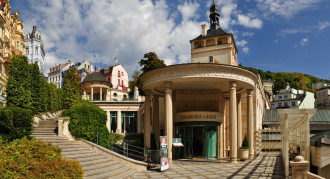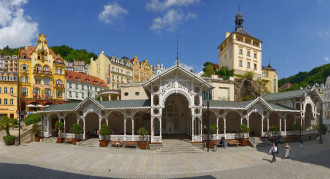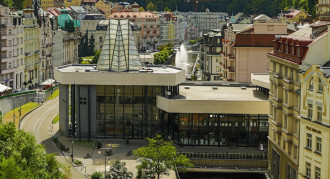The stone Mlýnská kolonáda (Mill Colonnade) was built in Pseudo-Renaissance style according to the design of distinguished Czech architect Josef Zítek between the years 1871 and 1881. The colonnade attic gable is decorated with 12 sandstone allegorical statues representing the months of the year. Inside the largest colonnade in Karlovy Vary, you may find the seeps of five mineral springs: the Mill Spring, the Rusalka Spring, the Prince Wenceslas Spring, the Libuše Spring, and the Rock Spring. More history
Facts about the Mill Colonnade
Structure type: Stone colonnade built in Pseudo-Renaissance style
Location: On the left bank of the Teplá River in the spa centre of Karlovy Vary
Period of construction: Between 1871 and 1881
Architect: Josef Zítek
Official opening: 5 June 1881
Springs: Mlýnský pramen (Mill Spring), pramen Rusalka (Rusalka Spring), Pramen knížete Václava (Prince Wenceslas Spring), pramen Libuše (Libuše Spring) and Skalní pramen (Rock Spring)
Accessibility: Freely accessible
How to get there
Route 1: You may reach the Mill Colonnade if you walk from the Hot Spring in the city centre across Tržiště (Market) Street and up Lázeňská Street along Tržní kolonáda (Market Colonnade) on the left bank of the Teplá River. The spring seeps are located inside the promenade hall of the Mill Colonnade. The short walk through the spa centre is approximately 500 metres long and takes about 10 minutes.
Route 2:The second alternative is to travel by Bus No. 1 or Bus No. 4 from the "Tržnice" (Market) city bus terminal to the "Lázně III" (Spa III) terminal stop. From there, walk about 200 metres across Lázeňský most (Spa Bridge) over the Teplá River and continue along Mlýnské nábřeží (Mill Embankment) directly to the Mill Colonnade.
-
Libuše Spring
(61,5°C)
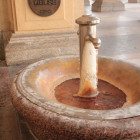
Water was supplied to the spring bowl from four smaller seeps located in the space below the orchestra pit. It had been known as pramen Alžbětiných růží (Spring of Elizabeth's Roses) until 1947 when it received its current name. Since the Libuše Spring is one of the thermal mineral springs rising on the premises of the largest colonnade in Karlovy Vary.
-
Mill Spring
(57,8°C)

The spring has been known since the 16th century and it belongs among the oldest captured thermal springs in Karlovy Vary. The Mill Spring was one of the first waters to be recommended for drinking cures in 1705. The mineral water from the spring was bottled and distributed all over the world.
-
Prince Wenceslas Spring I
(65,4°C)

The spring, originally called Bernardův pramen (Bernard Spring), is supplied to two spring bowls. In the late 18th century, it had been often compared to the Hot Spring because of its mighty geyser gushing to more than 4 metres. The water from the spring had also been used for the production of the traditional medicinal salt.
-
Prince Wenceslas Spring II
(58,6°C)
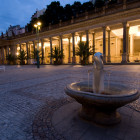
The spring, originally called Bernardův pramen (Bernard Spring), is supplied to two spring bowls. In the late 18th century, it had been often compared to the Hot Spring because of its mighty geyser gushing to more than 4 metres. The water from the spring had also been used for the production of the traditional medicinal salt.
-
Rock Spring
(44,9°C)

The Rock Spring originally rose directly from the bed of the Teplá River. A pool below Bernard's Rock was called Horse Bath back then as it was used for bathing horses. The spring was first drawn in 1845 after a part of the rock massif had been hewn and removed.
-
Rusalka Spring
(60,6°C)
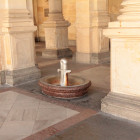
It was called Nový pramen (New Spring) from the mid 18th century and a new wooden promenade hall, the first of its kind in Karlovy Vary, was erected over the seep between 1792 and 1793. In the early 19th century, the New Spring thus became more popular and more sought after than the remaining springs in Karlovy Vary.
Location
Mill Colonnade
